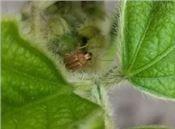|
Grape Colaspis In Corn And Soybean: A Pre-Season Primer

Fig. 1. A grape colaspis adult peeking out of a soybean trifoliate. The adults resemble bean leaf beetles in size and shape, but have
stripes along the back (on the “elytra” which are shield-like front wings that protect the beetle’s soft body).
Larvae, which feed below ground and resemble tiny white grubs, are the damaging stage.
Photo: Nick Seiter
DR. NICK SEITER
URBANA, ILL.
Grape colaspis is a common insect, but it only occasionally affects corn and soybean production in Illinois. However, 2018 was that rare year where “outbreak” levels of infestation occurred in parts of the state, resulting in stand reductions and, in some cases, replanting of damaged areas. Information can be tough to come by for an occasional pest like this one, but I will summarize what we know and what we should expect going forward.
Biology. Matt Montgomery provided some detail on the life cycle, identification, and habits of grape colaspis in a Bulletin article from 2003, which can be found here: http://bulletin.ipm.illinois.edu/pastpest/articles/200311b.html. (The date of the article gives you a rough idea of the last time we had widespread issues with this insect in Illinois). A couple of key points:
• Adult females lay clutches of eggs in the soil in fields of soybean, alfalfa, and other legumes in June and July.
• The larvae that hatch from these eggs feed on root hairs, gradually moving to larger sections of the roots.
• When temperatures begin to cool in the fall, the larvae
burrow down 8-10 inches into the soil profile, where they spend the winter.
• When temperatures warm in the spring, the larvae move back up the soil profile and resume feeding on roots. High populations of larvae at this time can prune roots and lead to stand reduction.
Management. Plants with grape colaspis damage may appear wilted, stunted, or as if they have a nutrient deficiency from above the soil surface. The damage is often patchy and most pronounced on high/well drained portions of the field. Uprooting damaged plants will reveal the larvae, which resemble white grubs but are much smaller. While plants will usually overcome the initial damage, severe feeding can kill plants and reduce stands. Because egg laying occurs in soybean, alfalfa, and other legumes, the damage can occur in rotated corn or continuous soybean.
Control. Any chemical control measures for grape colaspis must be applied at planting. Insecticide seed treatments with many of the same active ingredients as those used in corn and soybean have been used successfully for grape colaspis control in rice in the southern U.S. However, because of the sporadic nature of this pest in corn and soybean, there are limited data available for at-plant control options such as insecticide seed treatments and soil insecticides in the Midwestern U.S.
Consider these control options on fields that have a history of grape colaspis damage, referring to the label for correct use. Like many soil-dwelling insects, there are no viable rescue treatments for grape colaspis; once damage has occurred the only management decision is whether or not replanting is necessary on part or all of the field. (There are several resources available to examine the economics of this decision, including the IL Corn Replant Calculator which can be used to guide decisions during the season: https://go.aces.illinois.edu/CornReplantCalcWeb).
Remember, this insect is sporadic in Illinois; history suggests that issues in 2018 do not necessarily translate to another big year in 2019. Hopefully this one will pass us by this season, but learn to recognize this insect and its damage just in case. ∆
DR. NICK SEITER: Research Assistant Professor, Field Crop Entomologist, University of Illinois
|
|